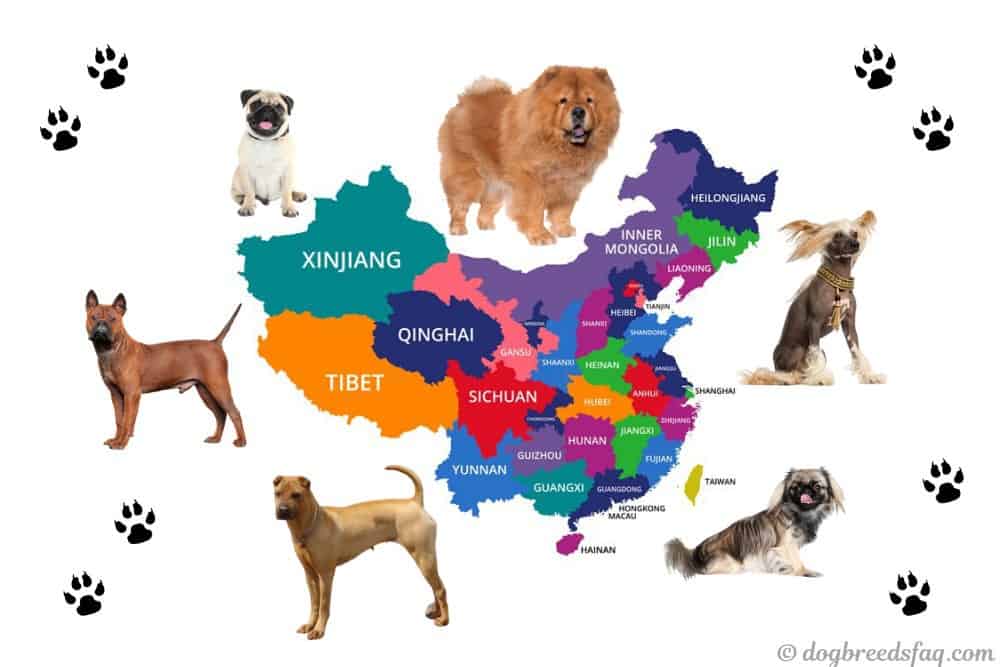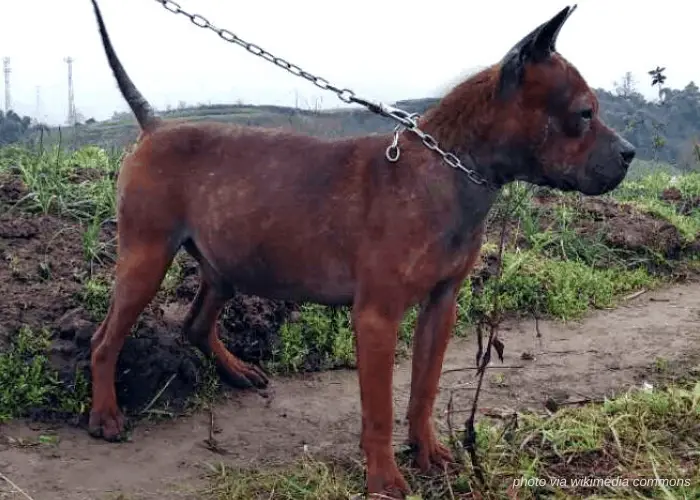If you’ve ever been to China, you might have seen some of their interesting dog breeds.
China is home to a wide range of breeds specific to the country, many of which are becoming increasingly popular worldwide.
Here is a list of some of the most popular Chinese dog breeds, including a rich history and fun facts.
Ready to get started?
1. Chinese Chongqing Dog
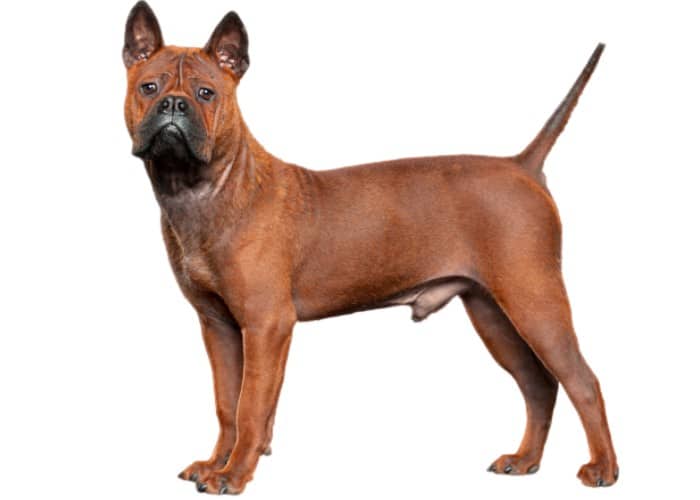
Chongqing Dogs are “smart, loyal, and protective” medium-sized dogs with short, bristly fur, a squished face, and pointy ears.
This breed is also known as the East Sichuan Hound and originates from Sichuan and Chongqing in southwest China.
Their coat color is reddish-brown or a dark brown color.
They have a very similar face to breeds such as bulldogs and pugs and have a perfect sense of smell.
Their original purpose was hunting dogs, as they had to sniff out prey.
The Chongqing Dog is one of the ancient Chinese dog breeds on this list and can be traced back to the third century.

An archeological dig found statues resembling the breed in a graveyard from the Han Dynasty, proving that it’s been around for some time.
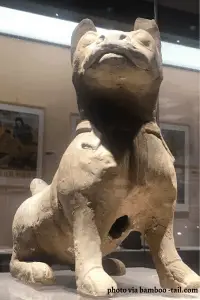 Back then, the statues were used to accompany the family into the afterlife, proving that they were seen as a very protective breed.
Back then, the statues were used to accompany the family into the afterlife, proving that they were seen as a very protective breed.
The breed was also used as a hunting dog, which has resulted in it being a very intelligent and loyal breed.
As with any other ex-hunting breed, they require plenty of exercise and mental stimulation.
The breed is very intelligent and can become bored quickly if they’re not entertained.
However, this is easily overcome if you’re willing to put in the effort of playing with the dog every day (which isn’t even that much effort after all).
Temperament
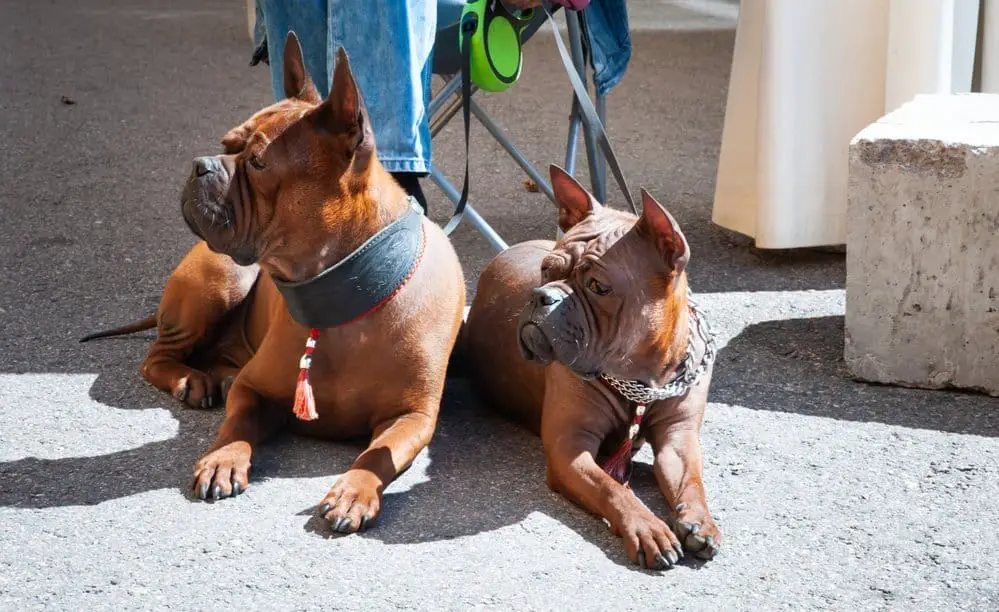
The breed has a very relaxed temperament but can be very protective of its owners and wary around strangers.
However, if the owner is present, they’ll quickly warm up to anyone.
They make a great family pet but require plenty of training to overcome their protective instincts.
They can be good around children but will need to be eased into the situation again.
Chinese Chongqing Dog Fun Facts
- Archeologists found sculptures bearing a strong resemblance to the Chinese Chongqing dog in an ancient tomb in 1987. They estimated the breed’s history to go back 2,300 years from the Han Dynasty!
- The Chinese Chongqing Dog is a rare breed that nearly became extinct during the mid 20th century because of the Communist Party’s persecution.
- Chongqing dog is one of the rarest dog breeds in the world. Today, the Chongqing dog is rarer than the Panda bears! There are only around 2,000 of them in China.
2. Chinese Crested Dog
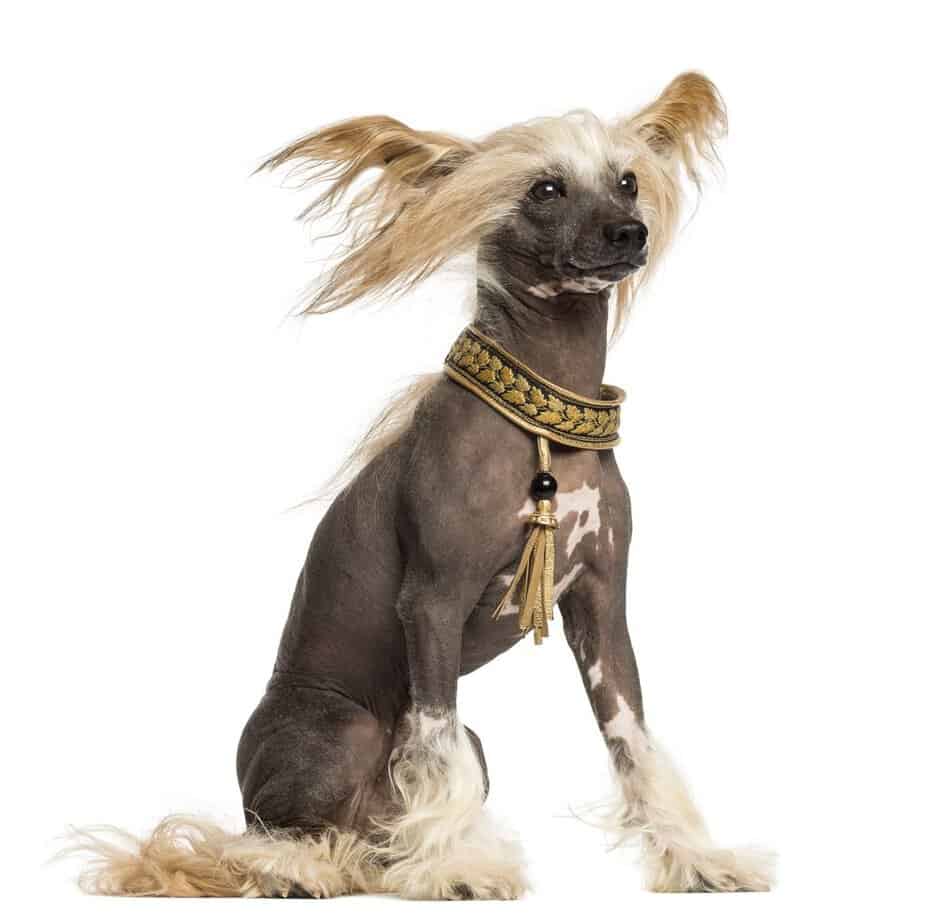
The loving, playful, and loyal Chinese Crested Dog is considered one of the small dog breeds in China.
They are probably one of the most recognizable breeds because of their unique appearance. According to some owners, they are known worldwide to be hairless dogs, but they are still getting blackheads.
They still have fur on their head, feet, and tails, hence their name’s “crested” part.
However, the rest of their body is entirely bald and is often characterized by spots on the skin.
Chinese Crested Dogs were originally bred to be companions for the disabled and elderly, so they have all of the desired characteristics of companion pet dogs.
Temperament
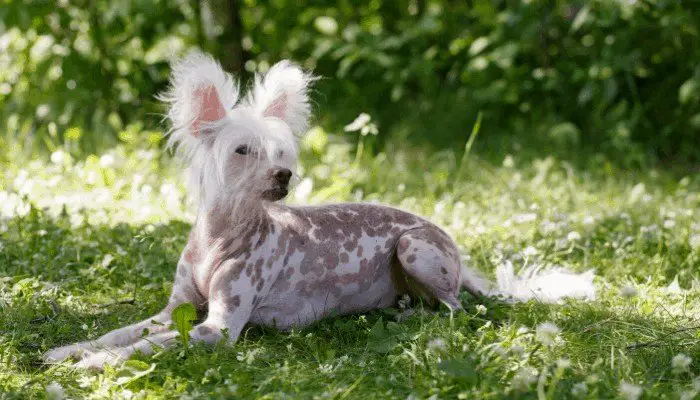
The dogs’ temperament is usually calm, very friendly with family members, and they often get on well with other dogs.
One of the best features of this breed is its intelligence.
They’re very easy to train, which is why they compete well.
Because they were specifically bred as companion pets, they don’t have the same desire for exercise as standard breeds, which is very helpful for some people.
They could be considered lazy, as their favorite hobby is sleeping. They’re still athletic enough to have a good run around when they want one.
Owners often praise the breed for its easygoing nature, and although they might not be the cutest in appearance, they certainly make excellent companion dogs.
Chinese Crested Dog Fun Facts
- The Chinese Crested Dog is quite a well-known breed because it won the world’s ugliest breed in 2003, 2004, and 2005. A Chinese Crested, Sam, was the winner of the ugliest breed these years.
- They are called “Chinese Crested dogs” because they were used on merchant ships by Chinese sailors for catching mice and other vermin.
- One amazing feature about the breed is that they have sweat glands. A well-known fact about dogs is that they pant to keep cool, but this isn’t true of the Chinese Crested, and it can regulate its temperature through its skin like humans.
- They are known as the “Dr. Seuss dog because they look like the characters in Dr. Seuss’s stories.
- There are two types of Chinese Crested Dogs: the hairless variety (with soft, silky hair found only on the head, feet, and tail) and the powderpuff, known for its long silky coat.
- Chinese Crested dogs are one of the longest-living dog breeds, with an average life expectancy of 15-17 years!
3. Chinese Imperial Dog
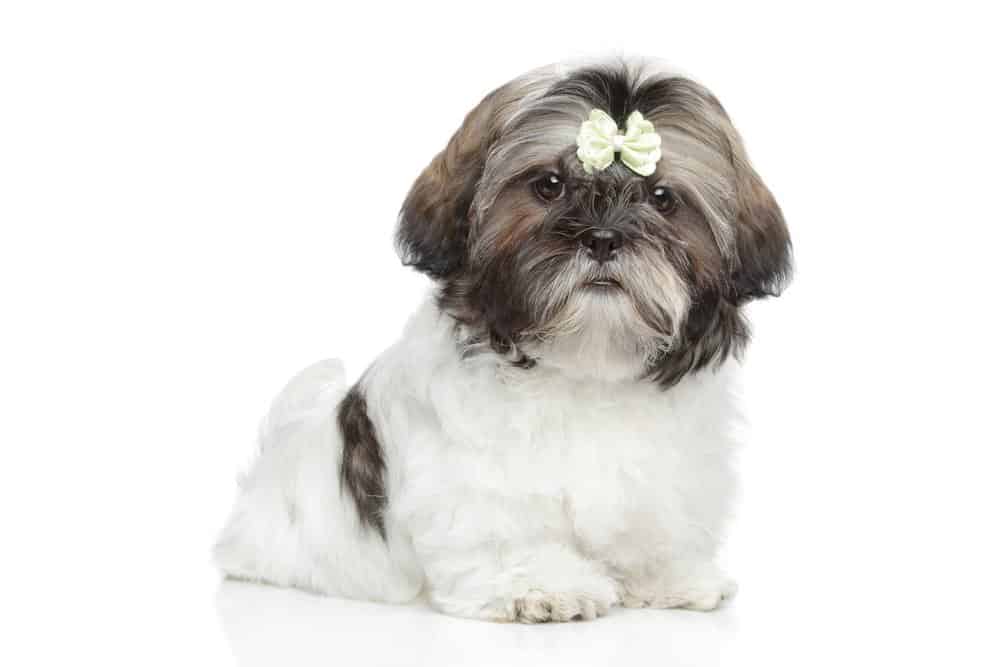
The Chinese Imperial Dog is another small Chinese dog breed (the “smaller” version of the Shih Tzu) and is considered a toy dog.
Although the two breeds aren’t closely related, they’re also known as the “Imperial Shih Tzu.”
It’s a translation of “lion dog,” as they’re another breed that’s thought to look like the lion guardians from ancient Chinese culture.
The royal family first bred in China as companion dogs; some smaller ones were carried in sleeves!
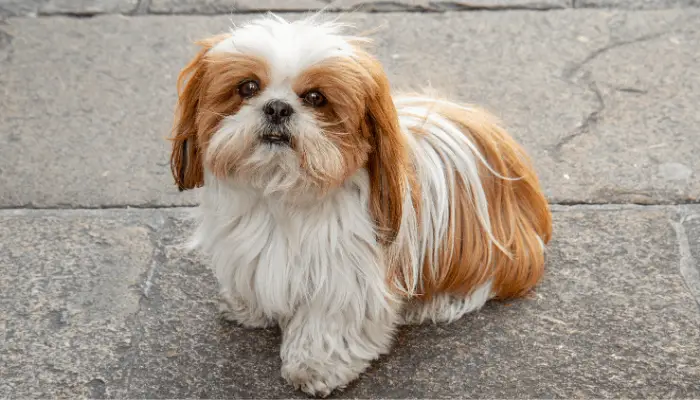
However, they’ve consistently been recognized as separate breeds in China. Its long and wavy coat knows the breed that’s also very dense.
The coat can be kept long or trimmed, but the trimmed version is more common for owners because it’s much easier to manage.
They still need regular grooming because the coat can become very matted otherwise.
Chinese Imperial Dogs come in many colors, but a black-and-white mix is the most common.
Temperament
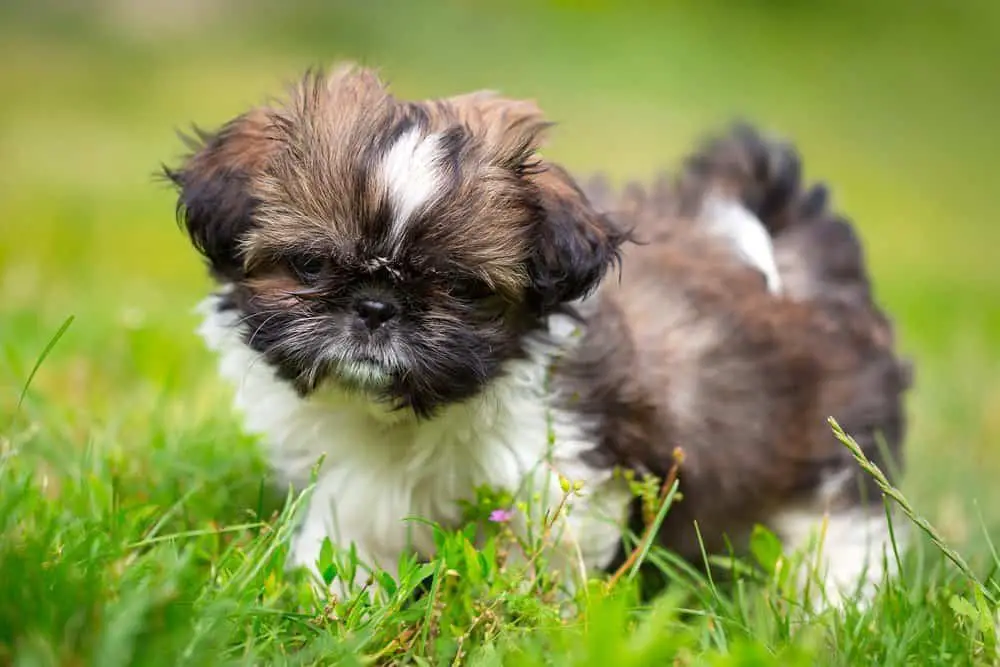
The breed is known for its calm and friendly temperament, resulting from being bred as companion dogs.
They can be very energetic and require more exercise than you’d expect for a small dog.
However, as they’re small dogs, simply playing with them in the house will often be enough.
The breed makes an excellent companion pet and does socialize well with other dogs, but be careful with them around children.
Like other small dogs, they’re much more susceptible to unintended injury.
Chinese Imperial Dog Fun Facts
- The breed is one of the oldest breeds in China and is believed to have been around for over 2,000 years, although the American Kennel Club has only recognized them since the 1960s.
- The main reason there’s debate over the breed’s origin is that although they’re not related, the breed is almost identical to the standard Shih Tzu but is much smaller.
4. Chinese Red Dog

The Chinese Red Dog is also known as the Laizhou Hong and is a sturdy-looking molosser type of dog with distinctive pointy ears.
It is a calm, affectionate, loyal, and friendly canine. They make great work dogs, guard dogs, and pets with an independent and eager nature.
The Laizhou Hong is intelligent with a broad, black nose and wide nostrils.
Their nasal bridge and muzzle are long and distinctive, as long as the dog’s skull, and they have lips that tightly fit the shape of their jaws.
Their gums can be dark, and they can also have dark spots on their tongue. They also have large paws compared to other dogs.
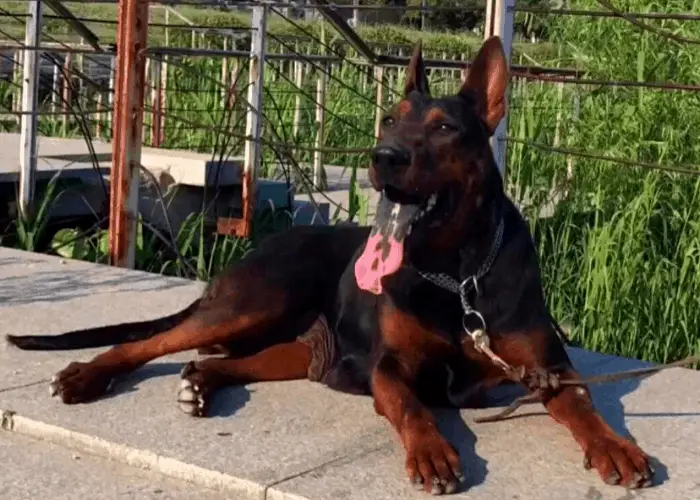
Their back legs are straight, well-defined, and strong. They have tight-fitting skin with dense, short fur that is smooth and glossy.
Their coats are black with brown marks on their muzzle, throat, face, legs, and chest. They also can have markings over their eyes and under their tail.
This dog at adult size usually weighs in at 45 – 60 kg. The height of the adult male is usually 25 – 31 inches, and the female 25 – 27 inches.
The Chinese Red does well in hot and cold climates and can be expected to live up to 15 years. It is best to live in a home with some outdoor area to run around as high-energy dogs need exercise and space to run around often.
Chinese Red Dog Fun Facts
- In the 19th century, German soldiers from the Shandong Xian Hound bred the Chinese Red dog and three German dogs (the German Shepherd, Rottweiler, and Great Dane). After some time, it became a breed of its own.
- They have strong jaws with a scissor bite.
- They need lots of exercises daily to satisfy their needs.
RELATED ARTICLE: The adorable Red Cantonese Bear Dog
5. Chow Chow
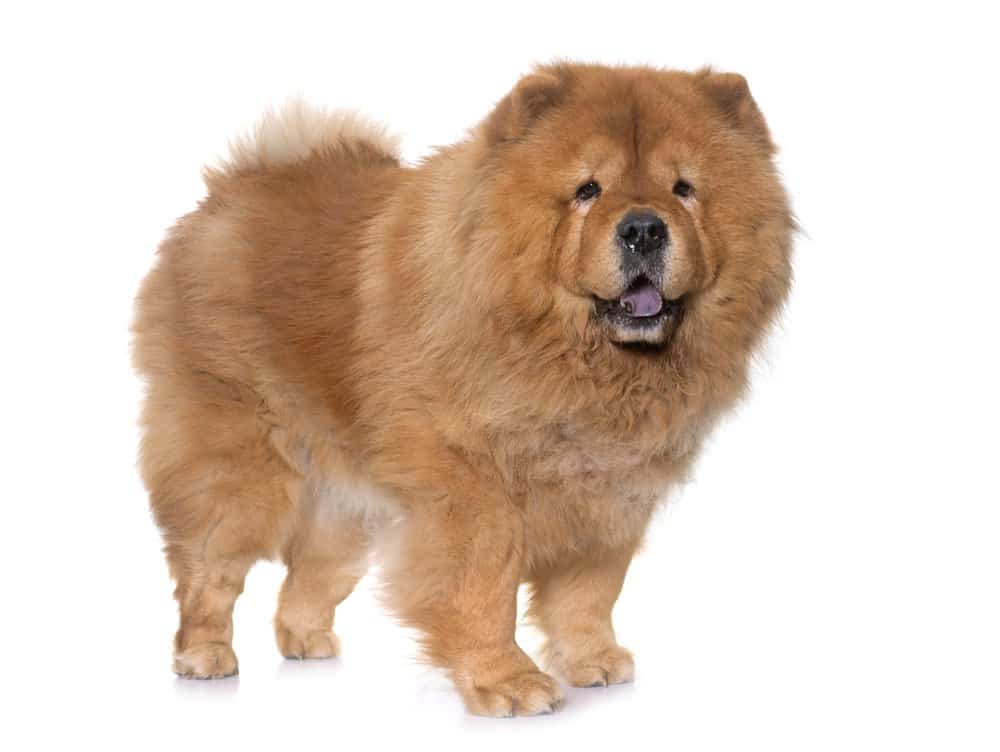
The “silent, dignified, protective and aloof” Chow Chow originates from Chinese indigenous dogs, and some historians believe it can trace its history back over 2,000 years!
They were initially bred as hunting and fighting dogs but were also used to pull sleds and are well adapted to the colder climates of northern China.
The breed is recognizable, but they’re not particularly popular for several reasons. (see “Did You Know?”)
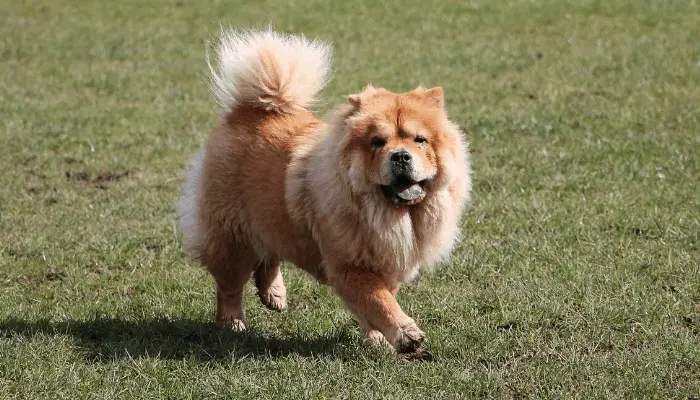
However, if you take the time to look after a Chow properly, they can become a loyal companion.
These large dogs are known for their stocky appearance and have square heads and large bodies.
Their fur is very thick and fluffy and can be soft or rough.
Chows also have curly tail that sits across their back. The standard color for the breed is cream or fawn, but they are also seen in black and red.
There are rules around the acceptable color for dog shows, with fawn being the most popular in competitions.
Temperament
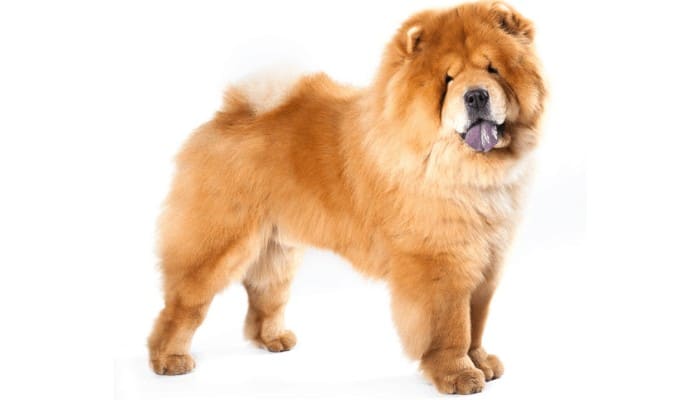
Regarding temperament, Chows can be very wary of strangers, and owners should take care when walking them in public spaces.
While the breed isn’t known to attack strangers, they can get very protective if they believe their owner is under threat.
They’re not very active dogs but need daily exercise to prevent boredom and weight gain.
To prevent aggressive tendencies from developing, owners are recommended to socialize them very early.
Chow Chow Fun Facts
- Because of its large size, Chow Chow is best known for looking like a “giant teddy bear.”
- Chow chows were very popular during the Tang Dynasty, and there were reports that a Tang Emperor owned over 5,000 Chow Chows. The Chow Chow is the Tang Quan, or “Dog of the Tang Empire.”
- They are not the friendliest dogs and are often described as aloof by owners and breeders.
- They don’t do well in hot climates, which rules them out to many potential owners, and can be challenging to manage.
- They are best known for their blue-black tongues (one of only two AKC-registered breeds with such features), a unique feature not seen in many other dog breeds.
- There is no White Chow-chow. Many breeders describe their chow chows colors as champagne, silver, lilac, chocolate, or WHITE, and all of these are just “fancy names” of chow chow’s standard colors.
6. Chuandong Hound
The Chuandong Hound is a handsome medium-sized dog with a red/orange-colored single coat. It has a strong jaw and pointy ears, active, courageous, and energetic.
They are excellent guard dogs but unsuitable for police work or other similar industries as they tend to be too dominant and ignore the rules if overexcited.
But they can be well-trained with some time and effort on the owner’s behalf and are eager to please their master.
They have been trained in the U.K. to work as therapy dogs. Also, they make great pets and are caring and mindful around children.
The Chuandong Hound needs a firm owner who will spend time training the dog properly.
This lively hound also needs a lot of exercise and time outdoors and will happily run with its owner.
Comparisons can be made with the Chongqing dog. The Chuandong Hound is bigger and has a red coat, whereas the Chongqing can be red and black. Both are naturally hypoallergenic.
Chuandong Hound Fun Facts
- Its tongue is blue or has blue spots on it.
- Some puppies are born with a black mask which usually fades with age.
- The life span of the Chuandong Hound is amazingly long 16 – 20 years.
7. Formosan Mountain Dog
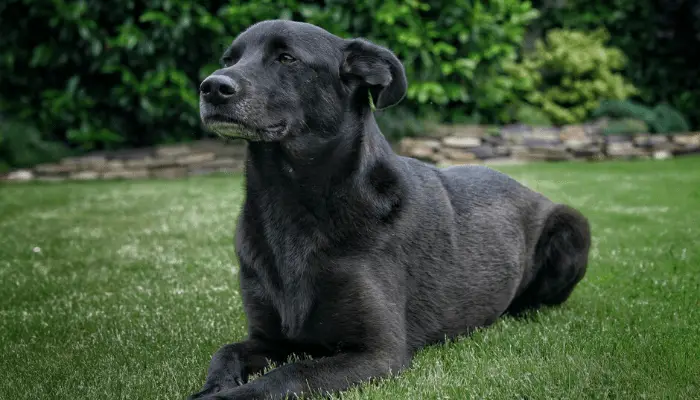
The “faithful, alert and intelligent” Formosan Mountain Dog is thought to be one of the oldest dog breeds globally, and its history can be traced back to over ten to twenty thousand years ago.
In ancient times the breed was used as a hunting companion, and they are the descendants of hunting dogs from South Asia.
Today the breed is often found roaming the streets of Taipei but can also be found in homes as a watchdog and companion.
Many Formosan Mountain Dogs have been brought to the U.S. to rescue many abandoned dogs found in Taiwan.
That said, it’s extremely rare to find a purebred of the breed, and most purebreds are located in Taiwan purely for conservation reasons.
Temperament
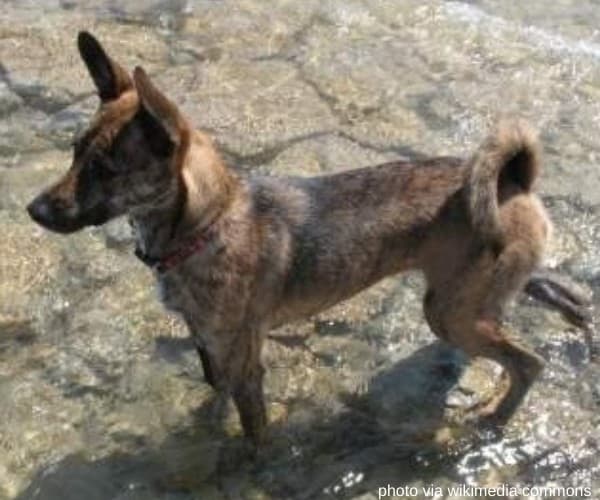
The Formosan Mountain dog is an extremely territorial breed, making it the perfect choice for a guard dog.
Though they are standoffish around strangers, they are very different from members of their families.
Regarding family members, Formosan Mountain Dogs are incredibly loyal. Though they do well will all family members, they strike a closer bond with one family member.
The Formosan Mountain dog does well with children. With that being said, they don’t deal well with rough behaviors, so children need to learn to respect their boundaries.
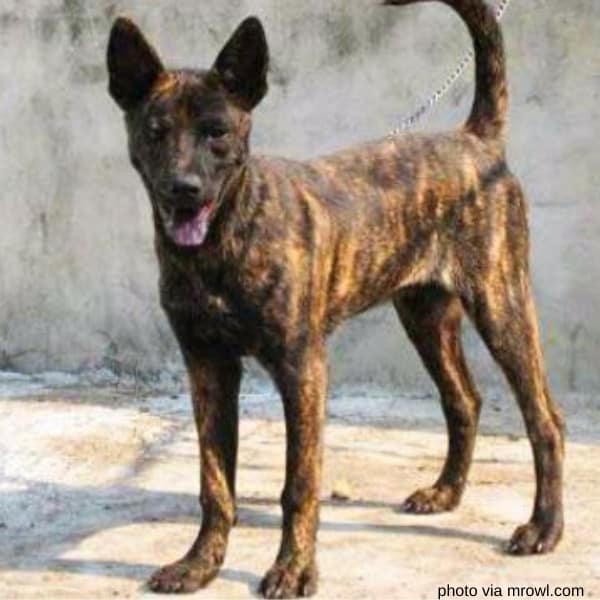
When it comes to other animals, the Formosan does have some aggressive tendencies. Because they have a strong prey drive, it’s not unlikely that they will attack a cat or rabbit.
They don’t always do well with other dogs but can get along if raised together from puppyhood.
Formosan Mountain Dog Fun Facts
- Very few Formosan Mountain Dogs are bred in the United States. Most are rescues from Taiwan.
- The Formosan Mountain dog has a spotted tongue.
- In 2015, a British Royalty family adopted an abused Formosan Mountain Dog in California.
8. Japanese Chin
Granted, as the name indicates, “Japanese Chin,” this noble, affectionate, playful, and loyal breed isn’t considered a popular Chinese dog breed. Still, the origin of the breed is a hotly debated issue.
Many believe it arrived in Japan through the Chinese or Koreans, which is why it’s ended up on this Chinese dog breeds list.
Owing to this debate, no one is completely sure when the breed arrived in Japan, but the consensus is between the 8th and 11th centuries.
Temperament:
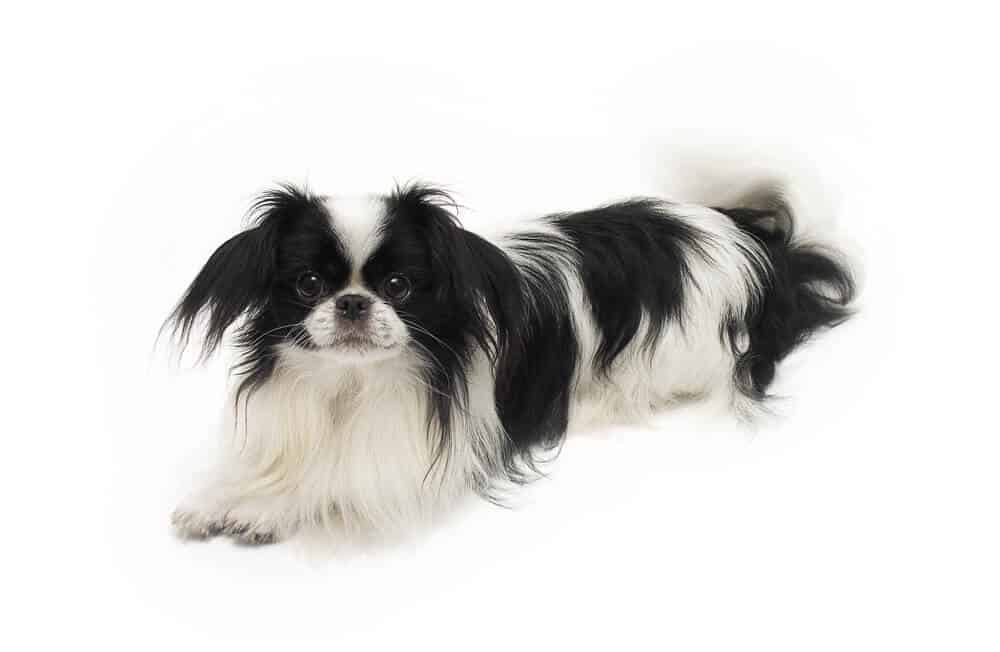
The breed is considered more like a cat in temperament than a dog.
They’re independent and talented and even wash their faces with their paws. They’re very friendly dogs and have built a reputation as therapy animals.
They can be trained very quickly and respond well to dog commands in Chinese or other languages or learn new tricks.
Like other lapdogs, they don’t require much exercise but should be taken out to relieve boredom, if nothing else.
Japanese Chin Fun Facts
- President Franklin Pierce was the first person to own the Chin in the U.S..
- The Japanese Chins are ancient dogs that originated as Chinese dog breeds.
- When the Chin first came to Japan, they were not seen as dogs. Instead, they were seen as separate beings.
- They are likened to cats due to their agility and the way they wash their faces with their paws
9. Kunming Wolfdog

The “intelligent, brave, and confident” Kunming Wolfdog is named because it originates from a domesticated dog breed being crossbred with a wolf.
This gives the breed a wilder appearance and also affects temperament.
The Kunming Wolfdogs are commonly used as police dogs in China and are trained to detect mines.
However, they also make popular pets for many families.
Think of them as essentially the Chinese equivalent of a German Shepherd (they look similar).
The breed is relatively recent compared to others on this Chinese dog list.
They were created in the 1950s specifically for military assistance, and although there isn’t an official breeding list, they can count German Shepherds as their ancestors.
Other than that, there isn’t much evidence regarding other breeds that created the Kunming Wolfdog.
They have a double-layered coat similar in color to a German Shepherd, and they shed it twice a year with seasonal changes.
They have long tails usually carried low but can lift when excited.
Although their coats are usually black and brown, they have been known to cover a range of colors, including rust and straw.
Temperament
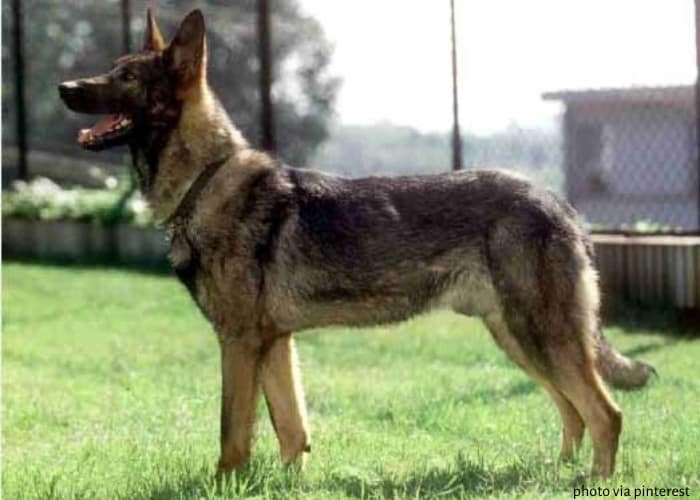
The breed is very intelligent and can be trained quickly and easily.
This is why they’re used as military dogs, making them great pets.
However, they require plenty of exercises and mental stimulation, which unfortunately rules them out as assistance dogs.
They still make excellent family pets and guard dogs and will be loyal to their family.
Kunming Wolfdog Fun Facts
- Kunming Wolfdogs resulted from German shepherds and wolves crossbreeding
- In August 2019, China’s first cloned police dog, an eight-month-old Kunming wolfdog named Kunxun, passed the police dog assessment and became an official k9 detective.
10. Lhasa Apso
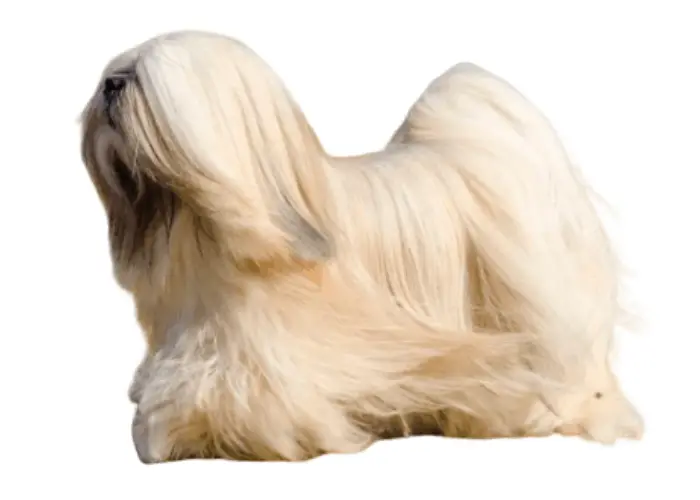
The first historical recordings of the “loyal, watchdog, and comical” Lhasa Apso date back to 800 B.C.
They were only kept by monks and nobility and were used mainly for guarding and protecting during this time.
Because the breed was commonly found watching over temples and monasteries, it was considered very sacred.
The only time there were allowed to be transported out of the country was when the Dalai Lama gifted them.
Lhasa Apsos were thought to bring prosperity and good luck when gifted by the Dalai Lama.
The first pair of Lhasa Apsos sent to the U.S. were gifted to Suydam Cutting in 1933.
Shortly after that, in 1935, the breed was officially accepted into the AKC and has long been welcomed into American homes.
Temperament:
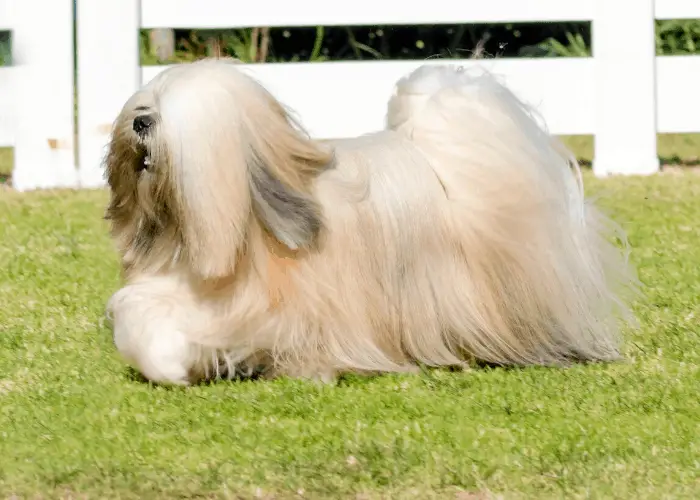
The Lhasa Apso was long bred as a guard dog, so they often are aloof with strangers.
They have a sharp bark that alerts their family when strangers are nearby, but it can become a nuisance if the breed is not properly trained when barking is acceptable vs. when it is not.
Though the Lhasa Apso can be wary of strangers, they are very loving and affectionate with their families.
They require much human companionship and socialization from a young age to prevent snippy behaviors.
Young socialization is also required for the Lhasa Apso to do well with other dogs and pets.

They also tend to mature slower than other breeds, so extra patience is required when raising this breed.
Though the Lhasa Apso loves to be around their family, they are also extremely independent and don’t mind being alone.
Though a short walk will be welcomed, this breed doesn’t require much exercise and is more than content, spending most of its time indoors.
The breed is often described as curious and playful, and owners often refer to them as little comedians.
Lhasa Apso Fun Facts
- Many people believe that when the owner of a Lhasa Apso dies, their soul enters into the dog’s body.
- You can expect to see a Lhasa Apso in “Lady and the Tramp.”
- The name “Lhasa Apso” means “Bark Lion Sentinel Dog.”
11. Manchurian Hairless Dog
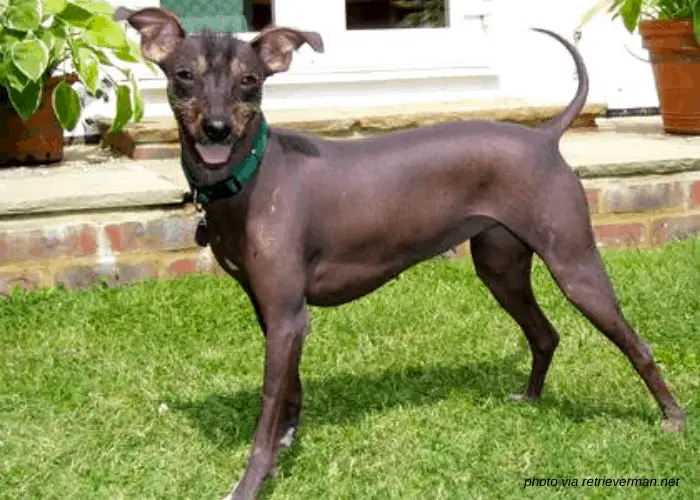
The Manchurian hairless dog, also known as tai tai, is rare even in China.
The small dog is playful and friendly and also protective of its owner. It makes a great pet and mixes well with other dogs.
Its domed head, short nose, and naked skin make the Manchurian Hairless dog special and unique. It is the Chinese Crested dog’s cousin, and some have hair on the tail, feet, and head.
It comes from the Northern regions of China, a surprisingly cold place for a hairless dog to originate.
Manchurian Hairless Dog Fun Facts
- The Manchurian Hairless has a lifespan of 12 – 15 years.
- Since they don’t have hair, they don’t smell or get fleas.
- It may have dental and skin issues.
12. Pekingese

The “noble, aloof, and dignified” Pekingese is also known as “Lion Dog” because they look like the ancient Chinese lion statues commonly found in temples and palaces.
They’re an ancient Chinese dog breed and are known as toy dogs.
This makes them count as a small Chinese dog breed, and they are, in fact, one of the smallest on this list.
The breed was originally kept by Chinese royalty as a companion dog, and that’s where its name comes from.

The Forbidden City, the seat of Chinese royalty, is located in Peking (now called Beijing).
However, this ancient Chinese breed has soared worldwide and is favored for its appearance and temperament.
The breed has hardly changed in the last 2,000 years and is known for its fluffy and long coat.
They can come in many colors, including fawn, black, brown, and cream, and typically have blackface.
Temperament
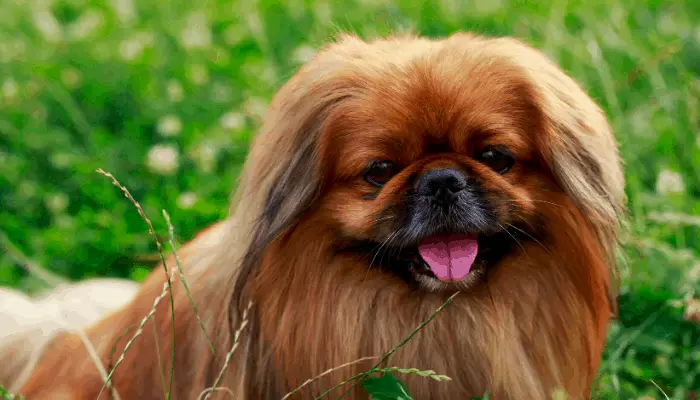
Because they were bred to be lap dogs, they’re very content to sleep all day but should be taken on walks to avoid weight gain.
They are independent, stubborn, difficult to train, and not fond of strangers.
With patience and proper training, calm, affectionate, and devoted companions.
One of the biggest commitments needed is the constant care of the coat.
It requires daily brushing and should be groomed every other month.
The fur should be trimmed around the face to avoid things getting in the eyes.
Pekingese Fun Facts
- Three out of twelve dogs survived the sinking of the Titanic. One of them is a Pekingese.
- In Ancient China, stealing a Pekingese was a crime punishable by death.
- The earliest known record of Pekingese is from the Tang Dynasty in the 8th century.
- They are known to snore loudly because of their short noses.
- The Pekingese is the most popular breed in China and one of the most popular dog breeds in the world.
13. Pug

The “lively, eager to please, and playful” pug is probably one of the most recognizable toy breeds globally and has held a special place in popular culture for many years.
Characterized by their squished face, bulging large eyes, stocky bodies, and curly tails, pugs have a long history in the East and the West.
Have you seen a pug with an un-squished face?
Or a pug with rare and controversial color?
When they were first brought to Europe, they became a popular companion for royal families.
Temperament
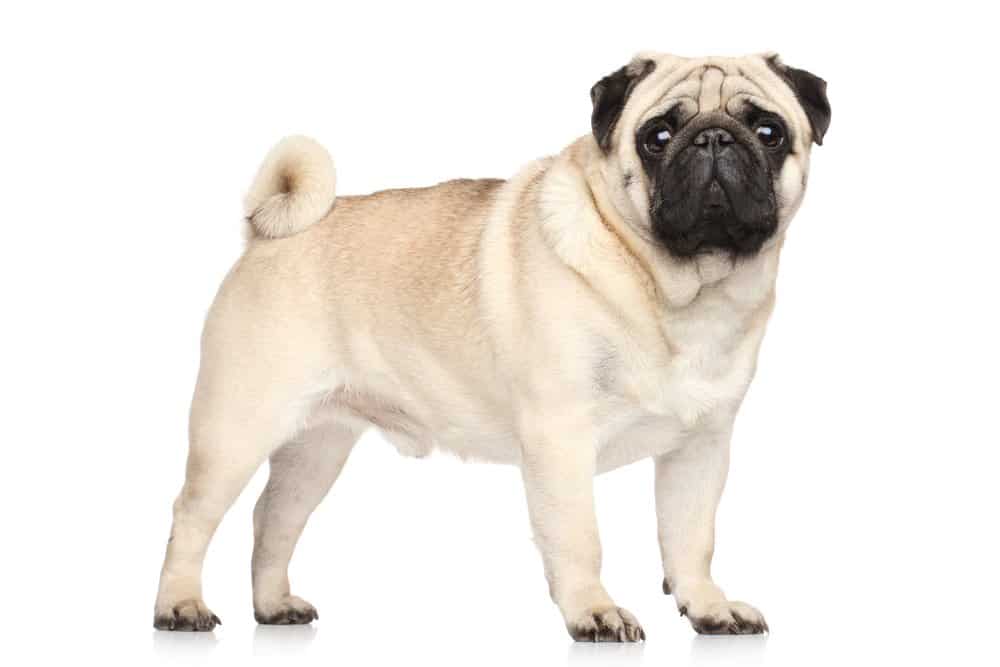
Pugs are among the popular small Chinese breeds known for their big personalities and friendly temperaments.
Pugs can be stubborn, but not in the wrong way, and they are easy enough to train if you’re committed.
They’re rarely aggressive and will get on well with other pets and children.
For this reason, they make great family dogs.
They’re surprisingly strong for their size and require more exercise than you might think for a small breed.
This is down to their high energy levels and the breed’s tendency to hold weight easily.
Due to their use as companion dogs, pugs appreciate the human interaction and know their owner’s mood changes.
They’re eager to please and should be played with regularly.
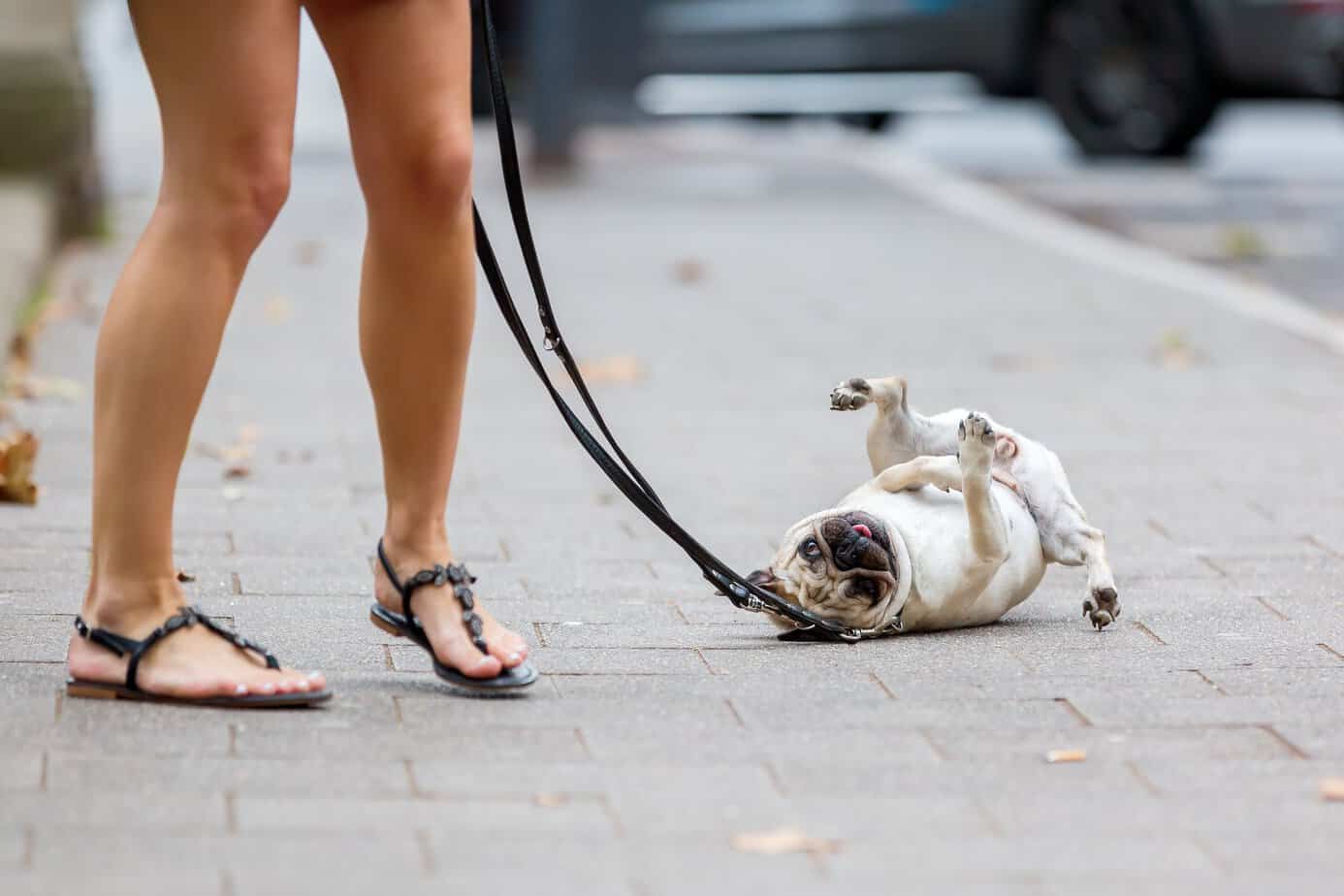
While they require plenty of exercise, pugs also appreciate sleeping for much of the day.
Pug FAQs:
- Do Pugs Shed?
- Can Pugs Eat Bananas?
- Can Pugs Eat Strawberries?
- Can Pugs Swim?
- Can Pugs Take Down Lions?
- What is a Platinum Pug?
- 25 Pug Look-Alikes
- What Does It Mean When a Pug’s Tail Is Down?
Pug Fun Facts
- Confucius (551-479 BC) wrote about pugs during his time.
- Pugs’ existence is thought to date back to 400 BCE!
- They love to sit on sofas or furniture.
- Being brachycephalic breeds, many pugs suffer respiratory-related health issues.
14. Shar-Pei

The “calm, independent, loyal and affectionate” Shar Peis are known worldwide but have never taken off as a famous dog. However, they have a special place among dedicated breeders and owners.
Shar Pei’s have small, triangular ears that sit on top of their head and a tail that curls over their back.
The standard color for a Shar Pei is fawn or cream, but kennel clubs recognize over 16 colors.
They have a blue-black tongue, which is only seen in the Chow Chow, one of the original species the Shar-Pei was bred from.
Three Types Of Shar-Pei
1. Bone-Mouth, a.k.a. Chinese Shar-Pei

It is the “original” or the Traditional type of Shar-Pei but is probably less recognizable to many reading this list.
The breed has quite a distinctive look and several unique features.
It has fewer wrinkles, shorter fur, a “roof-tile” muzzle, short hair, and a more pointed tail, all of which set it apart from its better-known cousin.
Typically, bone-mouth is favored in darker colors and usually found in black, blue-black, and black with rust.
However, lighter colors, such as fawn and cream, are found, but breeders consider these less desirable.
2. Meat-Mouth or Western Sharpei
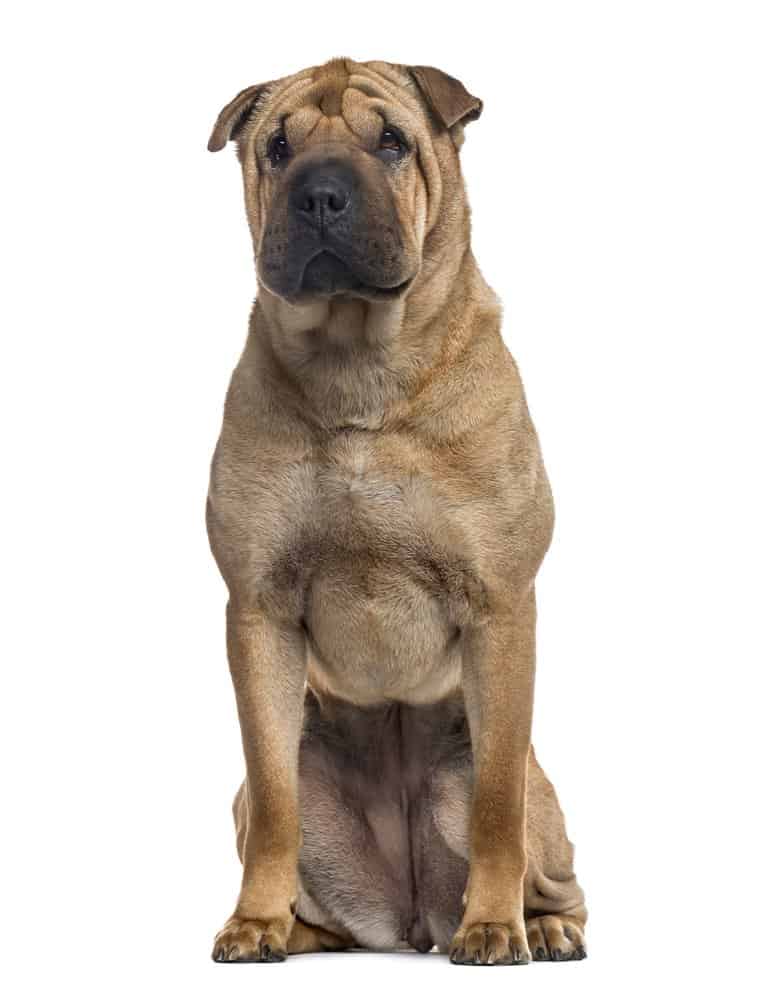
The Meat-mouth Shar-Pei is easily among the most recognizable Chinese dog breed lists. You won’t have difficulty spotting a Shar-Pei due to their unique loose skin and wrinkles, especially around the face and curly tail, heavy muzzle (or “hippopotamus look”) with fleshy padding, and longer hair.
They come in 3 varieties of coat types, namely:
- Horse Coat is rough, prickly, off-standing, soft in one direction, and harsh.
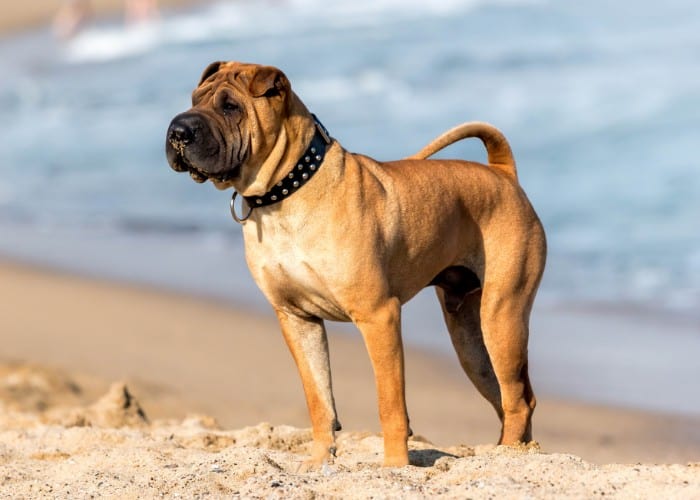
- Brush Coat – with longer hair and a smoother feel.
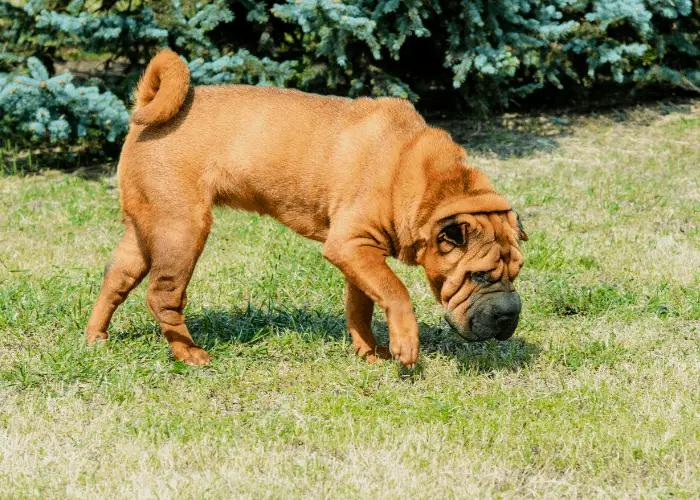
- Bear-Coat– long, soft coat.

3. Miniature Shar-Pei

As is probably obvious in the name, this breed is a smaller version of the Shar-Pei breed.
This makes it a small Chinese dog breed and is typically only 17″ tall at its biggest.
While this might not seem small, it makes them better suited to specific households and, therefore, an excellent family dog.
The breed was created by selectively breeding small Shar Peis together and isn’t counted as a separate breed.
The breed is identical to a normal Meat Mouth Shar-Pei, except they’re smaller. They have the same build, face, and characteristic facial wrinkles that identify the breed.
Temperament
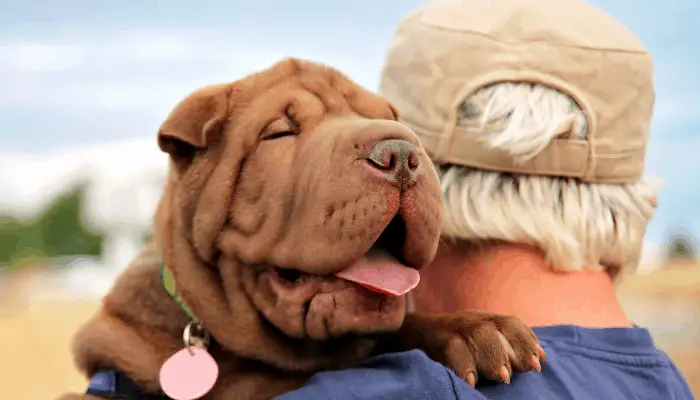
Shar Peis were originally bred as guard dogs, making them wary of strangers. Early training and socialization are essential to curb this behavior.
However, if this is done correctly, they will develop into incredibly friendly and loving dogs.
They are very loyal to their owners and are receptive to strangers if they are present and handle the meeting properly.
The breed is energetic and intelligent and requires plenty of exercises and mental stimulation.
If this isn’t handled correctly, the dog will become bored, which results in either depression or destructive behavior.
However, if appropriately exercised, the breed will be fine when at home
Shar-Pei Fun Facts
- “Shar-Pei” is a Cantonese word that means “sandy skin.” The breed was named “Shar-Pei” because its rough coat bears a sand-like texture.
- It’s been recognized by the Guinness Book of World Records as one of the rarest breeds in the world.
- Shar-Peis dates back to the southern provinces of China during the Han Dynasty, which existed over 2,000 years ago.
- The Meat Mouth is known in the West for its deep wrinkles, while the Bone Mouth, the traditional less wrinkled form, is maintained in Hong Kong.
- Shar-Peis are more prone to some health problems than dogs.
15. Shih Tzu
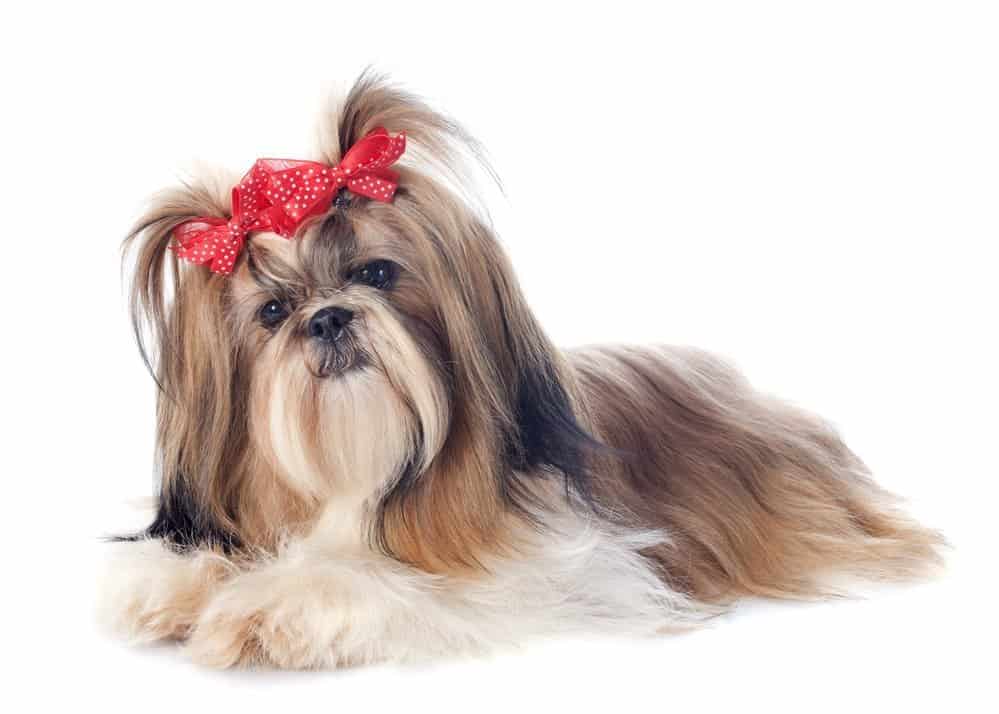
The history of the “lively, friendly, and good-natured” Shih Tzu dates back to the 7th century when they were often handed out as gifts to Chinese emperors.
Though the breed’s exact origins are unknown, they may have been developed through the crossbreeding of the Lhasa Apso or Pekingese.
While it is not certain, many believe that the Shih Tzu that Mongolian Emperors kept helping keep lions calm during lion training.
It was believed that this was why Shih Tzu’s earned the nickname “little lion dog.”
In 1928, the first pair of Shih Tzu was brought to England, and soon after, they also became popular in the U.S. The breed gained official recognition with the AKC in 1969.
Temperament
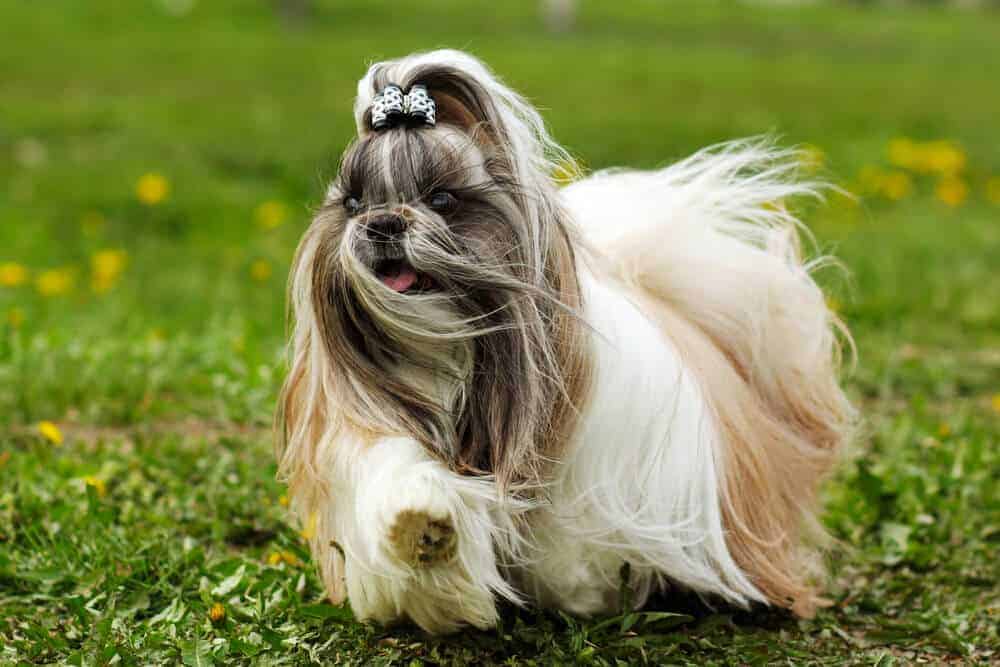
The purpose of the Shih Tzu has long been as a companion, and their personality remains reflective of that to this day.
Unlike many breeds of dogs that enjoy hunting, guarding, or retrieving, this small Chinese dog wants to be with its family members.
In return, the Shih Tzu can be described as an incredibly loving and affectionate dog breed. They require a lot of attention and love lying in your lap.
With that being said, though the Shih Tzu will happily curl up beside you, they are also extremely lively and alert.
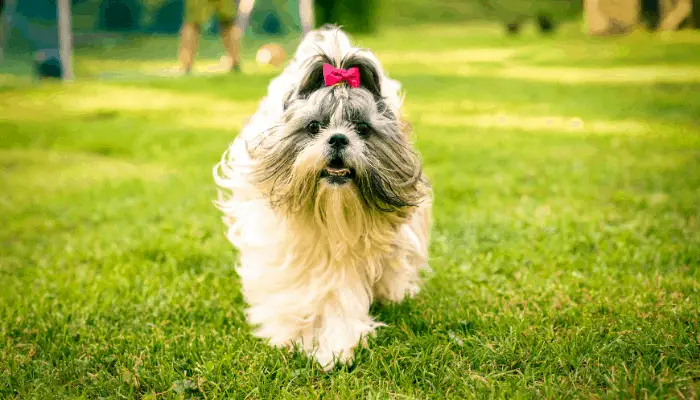
They will always let you know when strangers are in the home, though you will rarely find a Shih Tzu that will become aggressive.
In most cases, Shih Tzus do well with everyone, including children and strangers. Shih Tzus also do well with other dogs and pets in most situations.
Shih Tzu Fun Facts
- Recent research suggests that Shih Tzus are in the top fourteen oldest dog breeds, with origins dating back as early as 8 000 BC.
- Shih-Tzu is a dog that looks like an Ewok from Star Wars
- Paninging, the Shih Tzu, has taken over the internet! Photos of Paninging sleeping in unusual positions have gone viral, and the dog now has over 124 000 Instagram followers.
- Shih Tzus are considered excellent pets for adults or older children. They also get along well with cats and puppies or adult dogs.
16. Tibetan Kyi Apso
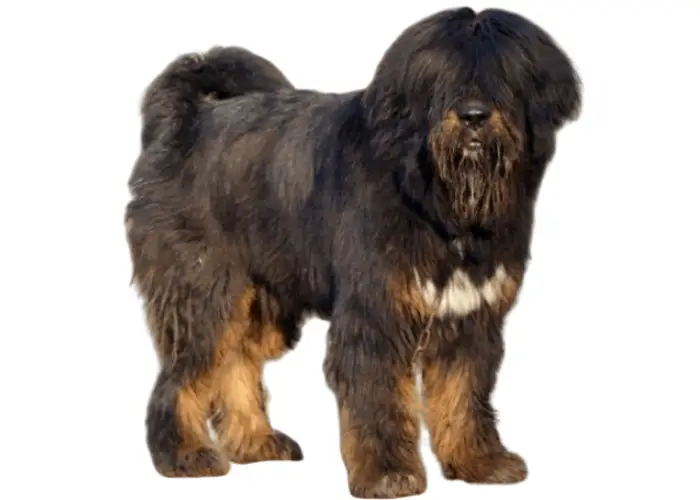
While the exact history of the “gentle and good guardian” Tibetan Kyi Apso, a.k.a. Tibetan Collie, is unknown, Tibetan art pieces suggest that the breed most likely dates back to the 17th century and probably originated in the Mount Kailash area.
Nomads commonly used the breed to herd and guard livestock. The breed was also known for having strong hunting instincts and good stamina and was also used for hunting down large game.
Though the breed did make its way into other countries in the 1970s, it remains rare outside of its native land. It has not yet gained recognition by any American Clubs.
Temperament:
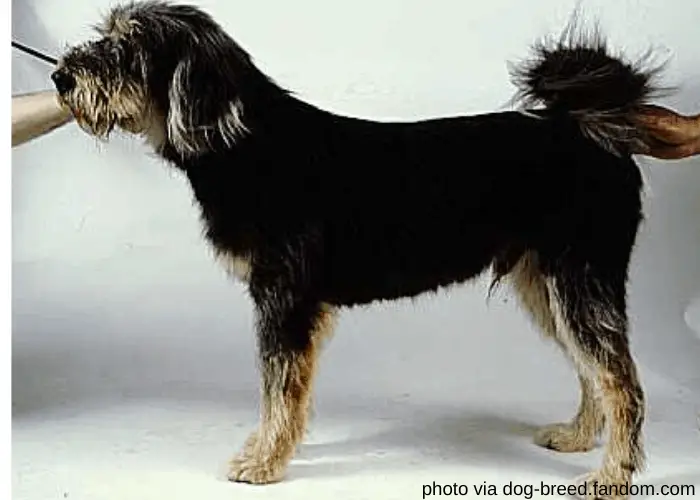
The Kyi Apso is often described as extremely brave and very affectionate.
They are a very dominant breed and therefore require an owner to establish themselves as the pack’s leader.
Because they were long used as guard dogs, the Kyi Apso has developed a strong suspicion towards strangers.
They will not let a stranger enter their territory without a challenge; sometimes, this challenge could become aggressive.
To prevent aggression toward strangers, early socialization is required.
The breed does very well with children and handles them very gently. Because the breed is so large, supervision is always required near young children to avoid accidents.
Tibetan Kyi Apso Fun Facts
- The name “Kyi Apso” translates to “bearded dog.”
- The name “Kyi Apso” can also mean “a dog that is tied,” insinuating that these dogs probably spent much of their time in history tied on chains.
- It is said that the 13th Dalai Lama owned a Kyi Apso.
17. Tibetan Mastiff
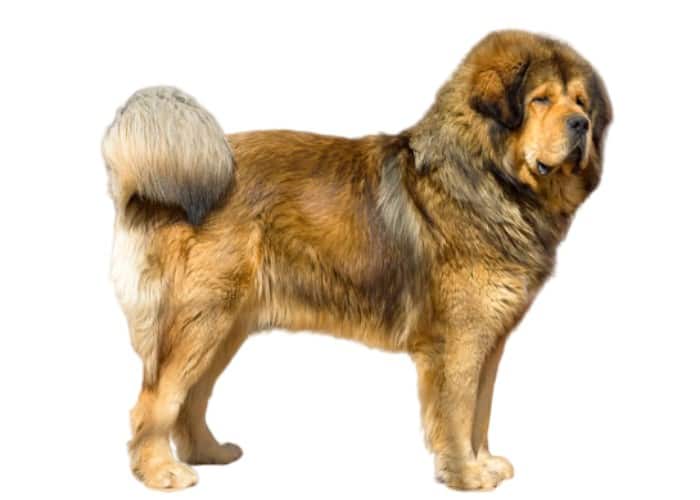
The history of the “strong, loving, and gentle” Tibetan Mastiff can be traced back to Tibet and is believed to have descended from Mastiff-type dogs that originated over 5,000 years ago.
The Tibetan mastiffs are well-known breeds from Asia aside from the chow and the Chinese shar-pei.
Unfortunately, due to a lack of documentation, little is known about the breed’s history before 1800.
The first Tibetan Mastiff transported to England was gifted to Queen Victoria in 1847. They were officially recognized by the England Kennel club’s Stud Book.
In 1931, the first breed club was formed for the Mastiff, but these efforts soon ended with WWII. It was not until 1976 that imports of the breed began again.
In 1974, the Tibetan Mastiff Club and the American Tibetan Mastiff Association were formed, and the AKC officially recognized the breed in 2007.
Temperament:

This large Chinese dog is a highly intelligent breed of very independent and self-sufficient dog.
The breed has a strong sense of self and will not tolerate being treated as a “pet.” Instead, they want to be treated equally.
Though the Tibetan Mastiff tends to be extremely loyal to family members, they can also be very stubborn, making them difficult to train.
For this reason, Mastiffs require an experienced owner who can establish themselves as the pack’s leader.
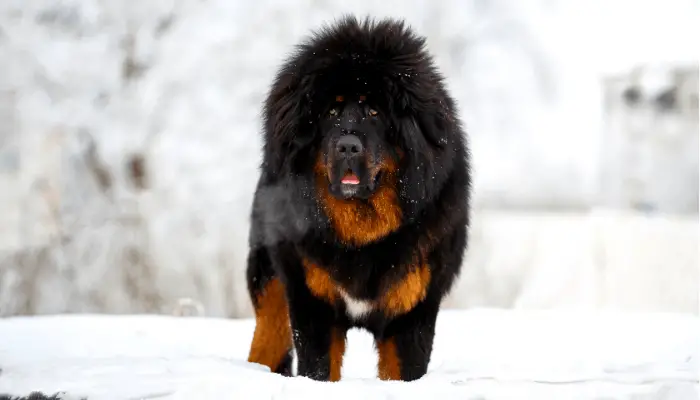
The Tibetan Mastiff is often extremely fierce and makes an excellent guard dog.
Though they are loving and affectionate towards family, they tend to be aloof towards strangers. This breed requires early socialization to prevent territorial aggression.
Tibetan Mastiff Fun Facts
- Many people in Tibet believe that Tibetan Mastiffs are hosts of the souls of monks, and nuns were not accepted into reincarnation or the heavenly realm.
- In Tibet, Mastiffs are often kept chained to fences during the day and let loose at night.
- Tibetan Mastiffs can survive high in the mountains and harsh, low-oxygen environments. According to studies, Tibetan Mastiffs share a pair of mutations with wolves that most other breeds of dogs do not have, and this genetic connection to wolves allows them to survive in such harsh conditions.
- The breed’s name-“Tibetan Mastiff,” is a misnomer and not a true mastiff.
18. Tibetan Spaniel
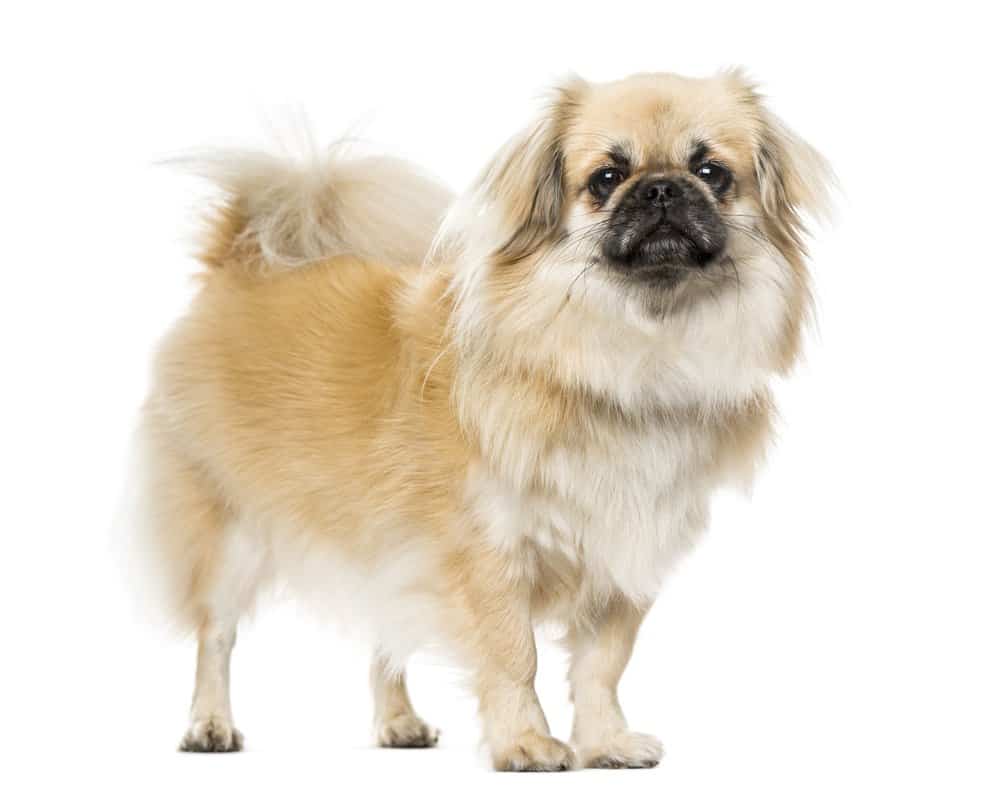
The “playful, confident, and intelligent dogs” Tibetan Spaniel is a small dog whose history is anything but.
Tibetan Buddhist monks originally bred the breed to be companions and alarm dogs.
The “Tibbies,” as they were nicknamed, were also commonly given to foreign dignitaries as gifts.
The first Tibetan Spaniel was brought over to England in the late 19th century, and the breed quickly gained popularity here until WWII, when it was wiped out.
In 1947, more Tibetan Spaniels were imported, and efforts were made to recover the breed.
In 1960, the England Kennel Club officially recognized it as a distinct breed. Since then, the breed has also made its way to the United States, where the AKC recognized it in 1984.
Temperament:
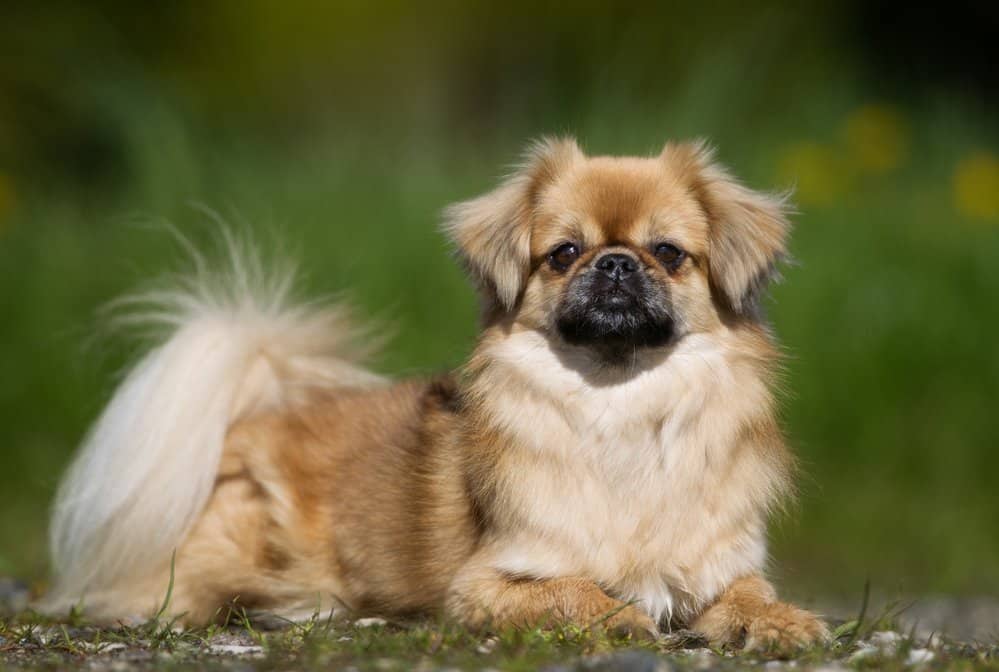
The Tibetan Spaniel is still an excellent watchdog, so they can often be somewhat aloof with strangers.
Unlike many other small guard dog breeds, the Tibetan Spaniel is not prone to excessive barking and will only bark if an intruder is near.
Though the breed is somewhat standoffish with strangers, they are extremely loving and affectionate towards their family members.
The breed loves to cuddle and seems especially responsive to people’s feelings and moods.
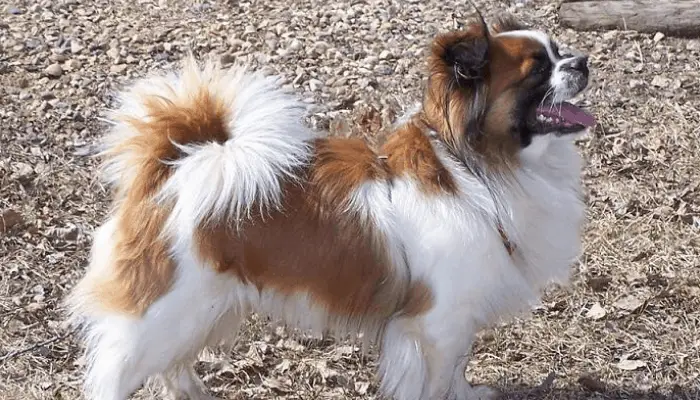
Even though the breed loves to cuddle up with their family members, they are also very independent thinkers.
They generally do well with training but can also be quite stubborn when they want to be.
The breed enjoys being active but doesn’t require as much activity as other dog breeds. Their small size makes them suitable for apartment or country living.
Tibetan Spaniel Fun Facts
- The new 2019 Lady and the Tramp movie features a Tibetan Spaniel who sings “He’s a Tramp” in the pound.
- Tibetan Spaniels have long been referred to as “Little Lions.” In Buddhist religions, lions are considered sacred. In return, Tibetan Spaniels are considered very honorable.
- Tibetan Buddhists believe humans are often reincarnated as Tibetan Spaniels and similar dog breeds.
19. Tibetan Terrier
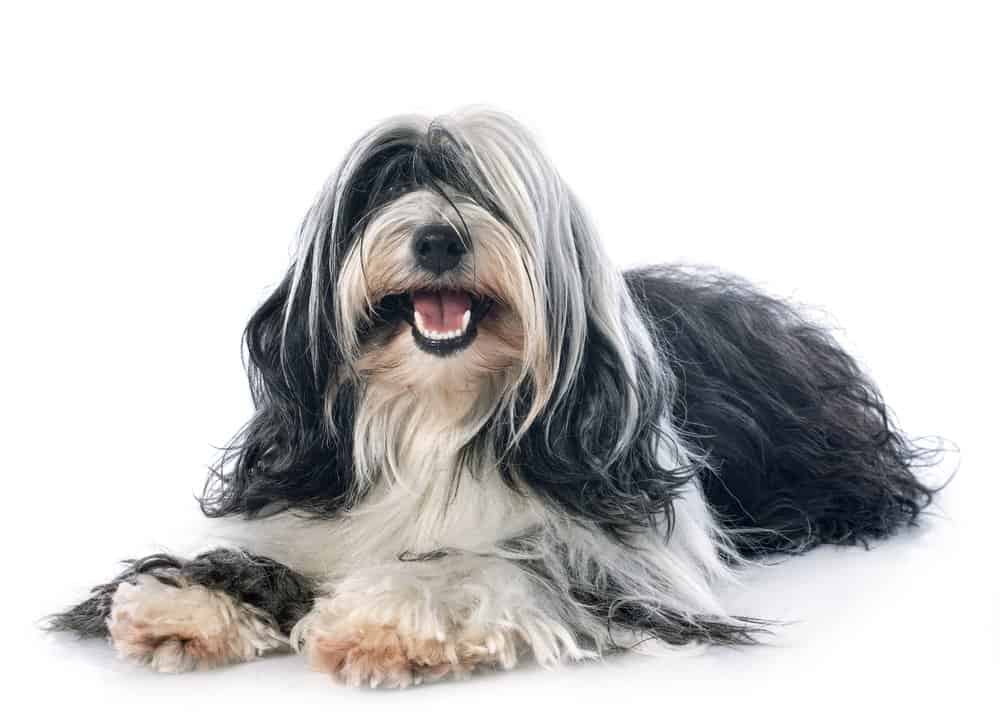
The “loyal, affectionate, and playful” Tibetan Terrier, sometimes referred to as the Lhasa Terrier, is an ancient breed that originated in the Tibetan Himalayas.
Believed to be one of the most ancient Tibetan dogs, this breed is an ancestor of the Lhasa Apso, the Shih Tzu, and the Tibetan Spaniel.
The breed was originally kept by Buddhist monks to be both watchdogs and companions but was also commonly gifted to local herders to be a guard and herd dog.
In fact, for many years, the Tibetan Terrier was so prized that it could not be bought; it could only be gifted.
The first Tibetan Terriers to be brought to Europe came over in 1922 (one male and one female).
These pairs were bred together and had their first litter in 1924. Since then, the FCI has recognized the Tibetan Terrier under the Tibetan dog breeds.
Temperament:

The Tibetan Terrier is an extremely loving and affectionate breed that thrives on attention.
The breed does not tend to bond closely with one family member but equally with all family members.
The breed is also considered very sensitive and reads human emotions very well. If the Tibetan Terrier senses sadness, it will do almost anything to cheer you up.
The breed is playful and good with children but will not tolerate rough behaviors.
As such, it’s always important to supervise small children around the dog and teach them how to respect the Terrier through gentle play.
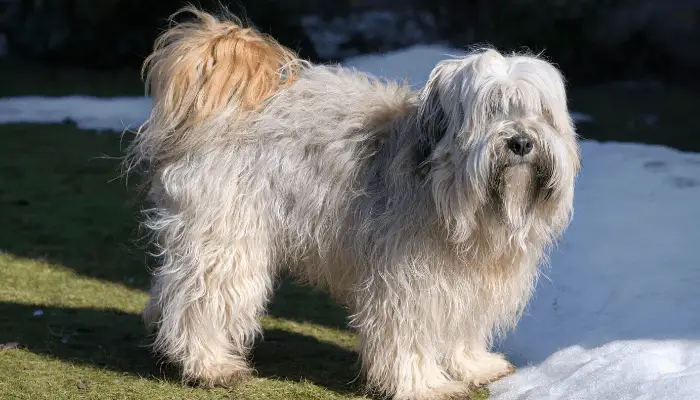
Though Tibetan Terrier is very loving and affectionate to family members, they tend to be standoffish towards strangers.
They are also extremely territorial, and for this reason, they make excellent guard dogs.
With that being said, while the Tibetan Terrier will alert you to a stranger’s presence, they are not considered aggressive and will not attack unless extremely provoked.
Tibetan Terrier Fun Facts
- Frank Lampard, Premier League Manager of Chelsea, equates his success in business to his Tibetan Terrier. According to Lampard, he has a specific walking, feeding, and training schedule with his dog that, if he misses, will hurt his success.
- Tibetan Terriers have long been regarded with extreme respect in Tibet and are often called the “little people.”
- Tibetan Terriers have long been known as “Holy dogs” and “bringers of good luck.”
20. Xian Hound

The Xian Hound is a graceful and elegant creature with long, strong legs. It has excellent power and stamina and can run very fast.
Its sleek figure can appear skinny to those unfamiliar with the breed’s appearance. They don’t carry much fat, especially from birth and younger years.
The Xian Hound is a strong-minded and independent breed of dog. It is devoted to its master but not friendly towards others, often appearing aloof.
Originating in China’s Shanxi province, the Xian Hound is a sighthound that hunts for game and protects against predators. It once chased and caught prey on the open, flat land of the Huangpu Plateau.
It has been known in China since at least 685 AD. It is less common these days, and Chinese people have been restricted from hunting as much as in previous times.
Paintings and drawings of the Xian Hound have been found on the walls of an ancient Qin Dynasty prince’s tomb dating back 2,500 years.
Emperors used this royal hunting sighthound for hunting games. Their history is thought to precede the records of the ancient silk routes.
Xian Hound Fun Facts
- The Xian Hound looks similar to a Saluki or Persian greyhound.
- Skeletons of the Xian Hound have been found in royal graves and sometimes wearing precious collars.
- They are now considered rare in China, and the China Kennel Association is trying to increase the numbers.
21. Xiasi Dog
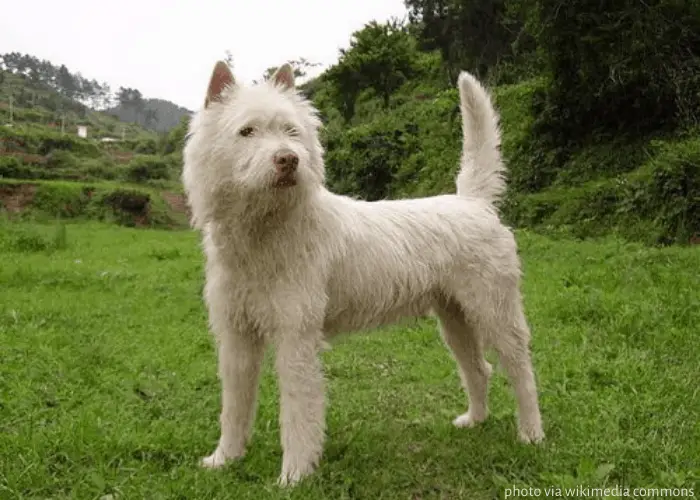
The “tenacious, loyal, and alert” Xiasi Dog, a.k.a. Xiasi Quan, is a breed considered Tugou and originates from the Guizhou Province in China.
It’s named after the town where it was originally bred and is still considered the center of the breed in China and the rest of the world.
Evidence suggests the breed was created in the 11th century and hunted small animals.
They are not particularly well known outside of China, and current estimates state that very few purebred Xiasi Dogs are left in the world.
Temperament
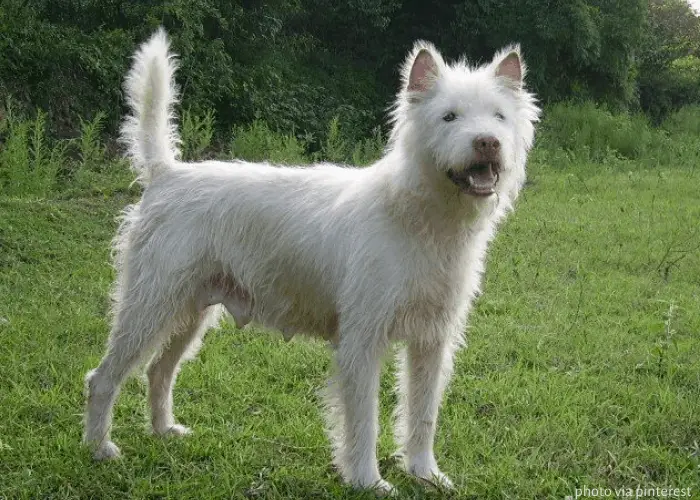
The breed is very intelligent and agile.
However, at the same time, the breed is very friendly toward humans and is very protective of its owners.
It was also used as a guard dog throughout China and is wary of strangers, particularly when its owner isn’t around.
The breed’s intelligence makes it very easy to train, and like many other hunting dogs, it shows a willingness to learn.
While this is useful for domestic owners, unfortunately, they’re still commonly used as fighting dogs in China and are often pitted against boars.
The dogs are judged on a range of things in these fights; unfortunately, they are still quite popular.
Xiasi Dog Fun Facts
- The Chinese believe that the Xiasi dog brings wealth to their family; that is why they have so much respect for the dog.
- Xiasi dogs are popular in boar-fighting competitions.
[youtube id=”Py1g8-cK4Ck”]
Conclusion:
Dogs are very popular in China.
As you can see in the Chinese Zodiac, the dog occupies the 11th position and the year of the dog occurs every 12 years.
Many famous Chinese dog breeds are increasing in popularity in the rest of the world, excluding obvious choices like pugs.
However, the rarity of many breeds is still reflected in their price, especially if you’re looking to buy from a reputable breeder.
One of the most important things to bear in mind is that many Chinese dogs require attention and might not be suitable for first-time owners.
Whether you get your dog of choice through a registered breeder or animal shelter-
The best place to start is by researching your desired breed to see how it fits in with your lifestyle, as many of these breeds still make excellent pets.


